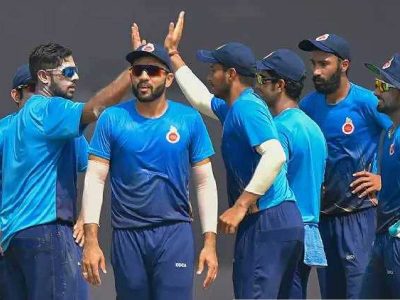The ball tampering episode in full view of high definition cameras makes one wonder where the game is going – and what cheating methods will be tried next
Now that Cricket Australia (CA) has announced a one-year ban on skipper Steve Smith and his deputy David Warner, the Indian cricket board (BCCI) has jumped to ban the duo from the cash-rich Indian Premier League (IPL) to showcase their high moral values in dealing with cheats.
The ongoing Test series in South Africa has been marked by controversy and drama in full view of the cricket fans all around the world. Australian rookie, Cameron Bancroft, was caught ball tampering. Team skipper Smith admitted his role by calling it “entire leadership call”.
Going by the confession of the player in question here, Cameron Bancroft, it was a piece of tape (yellow object), though others thought it was sandpaper to deteriorate the condition of the red cherry. The claims of Smith and Co has even opened up debate whether this tactic was the main reason for sweeping high-profile Ashes series just before the ongoing tour.
Brain fade
Not so long ago, Team India skipper Virat Kohli created a controversy by calling the actions of Smith & CO “a systemic cheating” while the Aussie team was touring India last year.
The incident that time involved Smith and Peter Handscomb looking at the dressing room for assistance while deciding whether to ask for a decision review. After that famous “DRSGate” episode played out in full public view, Kohli come out in the open to accuse Australian cricketers of repeatedly taking the help of dressing room to decide on reviews.
And the reply from Smith then was hilarious!
“It was a one-time brain fade,” was how Smith described his act.
But what followed then was not an act of regret from the Kangaroos. Rather, Cricket Australia’s chief went to the extent of saying that the Indian skipper “doesn’t know the spelling for sorry” after several of his outbursts against the visitors.
Unfortunately, the incident was never properly investigated and buried like many others in the past.
“There are lines you don’t cross on the cricket field,” Kohli then had said. Now, going back to what happened on March 24, 2018 in Newlands, Smith and his entire senior pros were forced to admit in the press conference following the television footage that “yes, we did break the rules of the game to win a Test”.
Thankfully, he stopped short of using the word “brain fade” for the second time in his career. According to Smith’s own words, “his leadership group decided to take matters into their own hands to get the ball to reverse”. And the player he chose to carry out his plans was none other but Bancroft, the junior-most member of the team.
Thanks to Smith and his so-called seniors, Bancroft is now part of cricketing history (even if the ugliest one) for carrying out the most ill-fated operation on a cricket field in recent times. He was seen with a piece of sticky yellow tape that he tried to hide, once caught, in his underpants.
Keeping everything aside for a minute, the sheer thought that their team could mastermind a win over the hosts by altering the condition of the ball with so many cameras trained on them is incredible. It’s amazing that Smith, Bancroft and Australia’s “leadership group” thought they could get away with it.
History of cheats
In an age of high definition cameras all around the ground, this is not one-off incident where eyebrows have been raised over the conduct of a famous player on the field.
The first of the most famous episode was performed by former England skipper, Mike Atherton. His “dirt in the pocket” incident was the first big incident to be caught on camera and forced the administrators to find ways to avoid any such repeat.
South Africa were not far behind. Faf du Plessis’ “MintGate” made waves when his team toured Australia last year, while his speedster Vernon Philander was caught “scratching” the ball in Sri Lanka before that.
But the most memorable act before Smith’s was the funny explanation by Pakistani veteran, Shahid Afridi, bit the ball in full view of cameras and officials in 2010. What he got in return, was just two-match ban.
This has certainly happened nowadays in the age of HD cameras. Just imagine what was happening before when there were no cameras around and John Level’s “Vaseline” episode shook the cricketing world in the late ‘70s.
One may call the Smith & Co incident as blatant, extreme, pre-meditated or even part of collective efforts by a desperate lot but the bigger question is what have cricket administrators have done to ensure “no repeat of ball management or foul play inside ground?”
Rulebook has flaws
Just like the “no-balls” were not spotted correctly before the introduction of DRS review, “ball management” isn’t noticed as often as it should be these days.
Going by MCC’s rule book, ‘ball management’ is allowed and happens all the time by polishing it on clothing of players or using an artificial substance like towel in order to dry up the red cherry. It is only when teams or players go overboard in their apparent effort to win at any cost that a line is crossed into illegality.
Be it Imran Khan or Wasim Akram or Waqar Younis, they all tried to twist rules to suit them. Sometimes, it was by legal means and many times by hiding cold drink bottle caps in their pockets, as has been alleged later on by players worldwide.
Considering the number of incidents and accusations under heavy camera policing now, perhaps the time has come for the International Cricket Council (ICC) to review its rulebook and code of conduct soon.
And if nothing like this is possible because for many the ICC is just a toothless body being heavily influenced by three rich countries — India, England and Australia — then perhaps the time has come perhaps to make ball tempering legal “by using a selective box of tools provided by umpires inside the ground”.
Even if the above suggestion is on a lighter note, one thing is for sure: that the Smith & Co exposé has changed the way cricket will now be watched by fans around the globe!





